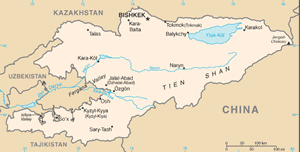The Geography of Kyrgyzstan
The Geography of Kyrgyzstan
Kyrgyzstani Geography
Location: Central Asia, west of China
Geographic coordinates: 41 00 N, 75 00 E
Map references: Asia
Area: total: 198,500 sq km land: 191,300 sq km water: 7,200 sq km
Area - comparative: slightly smaller than South Dakota
Land boundaries: total: 3,051 km border countries: China 858 km, Kazakhstan 1,224 km, Tajikistan 870 km, Uzbekistan 1,099 km
Coastline: 0 km (landlocked)
Maritime claims: none (landlocked)
Climate: dry continental to polar in high Tien Shan; subtropical in southwest (Fergana Valley); temperate in northern foothill zone
Terrain: peaks of Tien Shan and associated valleys and basins encompass entire nation
Elevation extremes: lowest point: Kara-Daryya (Karadar'ya) 132 m highest point: Jengish Chokusu (Pik Pobedy) 7,439 m
Natural resources: abundant hydropower; significant deposits of gold and rare earth metals; locally exploitable coal, oil, and natural gas; other deposits of nepheline, mercury, bismuth, lead, and zinc
Land use: arable land: 6.55% permanent crops: 0.28% other: 93.17% note: Kyrgyzstan has the world's largest natural-growth walnut forest (2005)
Irrigated land: 10,720 sq km (2003)
Natural hazards: NA
Environment - current issues: water pollution; many people get their water directly from contaminated streams and wells; as a result, water-borne diseases are prevalent; increasing soil salinity from faulty irrigation practices
Environment - international agreements: party to: Air Pollution, Biodiversity, Climate Change, Climate Change-Kyoto Protocol, Desertification, Hazardous Wastes, Ozone Layer Protection, Wetlands signed, but not ratified: none of the selected agreements
Geography - note: landlocked; entirely mountainous, dominated by the Tien Shan range; many tall peaks, glaciers, and high-altitude lakes


